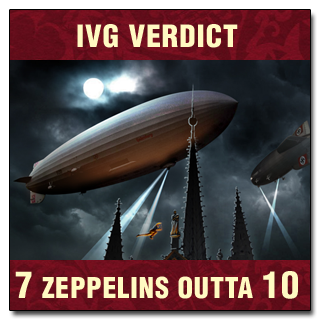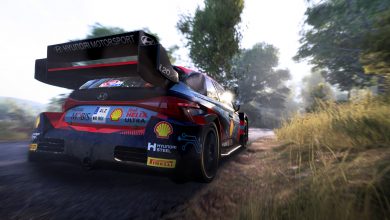Many people may have been turned off by the fact that The Saboteur is a World War II game. And you can’t really blame them thanks to the steady stream of generic Nazi-killing first-person shooters that have been shoved down our throats over the years. But The Saboteur isn’t a World War II game, it simply happens to play out in a World War II backdrop. You don’t play a soldier fighting for his country on the frontlines, but rather a man on a quest for personal vengeance in Nazi-occupied Paris.
[singlepic id=1701 w=450 float=center]
The Saboteur is a free-roaming, open-world action adventure game similar in structure to the Grand Theft Auto games. You play foul-mouthed Irish race car driver Sean Devlin, who is forced to flee Germany and head to Paris after the war breaks out. Once there, he embarks on a personal mission to avenge the death of his best friend at the hands of his racing rival, who also happens to be a top Gustapo agent. Somewhere along the line, Sean gets caught up in the Parisian resistance movement and simultaneously chain-smokes his way towards ridding Paris of the Nazis.
The most striking feature of The Saboteur is its rather unique visual style. When you start the game, all of Paris is under Nazi control. The city is dark and gloomy with only the yellow tinge of windows at night and red from Nazi flags, armbands and installments piercing through black and white monotony. It’s hard to tell night from day and when it’s pouring down as you drive through the streets of 1940s Paris to the brilliant soundtrack, it creates the perfect atmosphere.
[singlepic id=1702 w=450 float=center]
So it’s a jarring contrast when, once you complete missions and liberate areas by driving out the Nazis, the city takes on a look that wouldn’t seem out of place in a Disney animated film. It’s colourful and cartoony to a point where it’s almost gaudy, especially coming from the dreary and ominous settings of the Nazi areas. As you progress through the game and liberate more areas, you will start to miss the black and white visuals of the Nazi areas and the unique identity it lent to a game that otherwise struggles to set itself apart.
But more than losing that old-world charm, adding colour to the world also exposes the inadequacies in the game’s graphics. Low quality textures and poor lighting, which remained somewhat hidden in the black and white setting, jump out at you and become an eyesore in full colour. Character models and animations aren’t great either; in fact, they’re well behind the industry standard even for open-world games. I had no complaints from the city design though. It may not be historically or geographically accurate, but it looked close enough to what I imagined 1940s Paris to be. It has the Eiffel Tower, after all.
[singlepic id=1704 w=450 float=center]
As I mentioned, the mission structure is of the GTA ‘go here and talk to him’ variety, and the area liberation feature might sound similar to anyone who’s played recent games like infamous or Red Faction: Guerrilla. But The Saboteur is very much a game built on borrowed ideas, so similarities with other games don’t end there. You can climb pretty much any building in Paris and the platforming is very similar to Assassin’s Creed, but it’s implementation is a little rough around the edges.
Then there’s the stealth element straight out of Hitman. At any point, you can stealth assassinate a Nazi soldier and put on his uniform. This gives you a disguise that will let you slip by enemies outside a certain radius around you as long as your behaviour remains inconspicuous. Pull out a gun, start running, or jumping and that radius gets bigger, attracting more attention towards you. Stealth works well, but not perfectly, so it will be quite hard to complete the major story missions using only stealth. And that’s fine because stealth isn’t forced upon you. While some missions require it, you won’t be penalised for blowing your cover and you can continue your mission by running and gunning, which can be just as fun.
[singlepic id=1705 w=450 float=center]
Guns and weapons probably aren’t historically accurate either and the shooting mechanics aren’t the tightest. But the weapons sure do pack a punch and there’s lots of potential for massive explosions and frantic gun battles. There’s also a nifty perks system that rewards you for excelling in certain gameplay areas, such as sniping, stealth kills, driving, etc. Car controls are satisfactory considering you’re in the 1940s, when cars controlled like crap. It may take a while to get used to, but very rarely will you find yourself let down by your car in a chase sequence.
Chase sequences are inevitable, thanks to an alarm system similar to the wanted levels in GTA, which require you to escape a certain wanted area on the minimap to get the enemy off your back. Rather than escaping, you also have the option to hide in various hiding spots marked on your map. Contraband is the in-game currency and completing missions earns you contraband that you can spend on weapons at black market dealers stationed around the city. There are also garages and each time you drive a car into the garage it gets added to your collection, ready to be used at any garage around the city.
[singlepic id=1703 w=450 float=center]
The bigger missions in the game revolve mostly around infiltrating, killing and destroying, and they are laid out in a way that lets you explore both stealth and all-out assault approaches. From chase sequences through burning zeppelins, to car races, to sneaking into and destroying Nazi stongholds, there’s also enough variety in the missions not to feel repetitive. As you help in the resistance movement by completing resistance missions, you also unlock the ability to call in resistance fighters to help you during your missions. Completing main story missions helps liberate areas of Paris and moves the story forward, while completing side missions earns you contraband and appeases the completionist in you. Side missions involve blowing up Nazi installations such as AA guns, radars, sniper towers, fuel depots, etc. It may not seem like it, but these can be quite a fun distraction.
Sean Devlin’s character isn’t one that you will instantly like, but he grows on you as the game progresses. The voice acting also deserves a special mention. It’s so hilariously bad that it almost seems intentional and in a bizarre sort of way, it actually works with the game’s setting. It would be a crime not to mention the outstanding soundtrack, which is a mix of Jazz, Blues, and Big Band, and it makes driving around from mission to mission an absolute joy, especially in the Nazi areas.
[singlepic id=1700 w=450 float=center]
Conclusion
The Saboteur is a game that doesn’t take itself too seriously. It isn’t terribly original or historically accurate, and chances are that there’s nothing you will experience here that you haven’t already in other games. It is a game full of imperfections, but that’s where its charm lies. If you’re the kind to dissect and analyse a game’s every facet, stay away. But if you’re able to forgive its obvious flaws, The Saboteur is a blast and well worth the time you will spend playing it.
(+) Brilliant visual style in Nazi areas
(+) Decent mix of various gameplay styles
(+) Mindless fun
(+) Great soundtrack
(-) Lacks polish in every department
(-) Fairly buggy
(-) Uninteresting story, laughable voice acting
Title: The Saboteur
Developer/Publisher: Pandemic Studios/EA
Genre: Action-adventure
Rating: 18+
Platforms: PS3 (Rs 2,499), Xbox 360 (Rs 1,899), PC (Rs 999)
Join the discussion at the IndianVideoGamer Community forums




